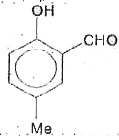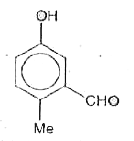:CCl2 is :
a free radical
a nucleophile
an electrophilie
none of these
The correct Answer is:C
Step by step video, text & image solution for ":CCl"_(2) is : by Chemistry experts to help you in doubts & scoring excellent marks in Class 12 exams.
Updated on:21/07/2023Topper's Solved these Questions
- BASIC PRINCIPLES OF ORGANIC COMPOUNDS (MECHANISM OF ORGANIC REACTIONS)BOOK - OP TANDONCHAPTER - BASIC PRINCIPLES OF ORGANIC COMPOUNDS (MECHANISM OF ORGANIC REACTIONS)EXERCISE - OBJECTIVE QUESTIONS (Level-B)
25 Videos
- BASIC PRINCIPLES OF ORGANIC COMPOUNDS (MECHANISM OF ORGANIC REACTIONS)BOOK - OP TANDONCHAPTER - BASIC PRINCIPLES OF ORGANIC COMPOUNDS (MECHANISM OF ORGANIC REACTIONS)EXERCISE - SET II
24 Videos
- BASIC PRINCIPLES OF ORGANIC COMPOUNDS (MECHANISM OF ORGANIC REACTIONS)BOOK - OP TANDONCHAPTER - BASIC PRINCIPLES OF ORGANIC COMPOUNDS (MECHANISM OF ORGANIC REACTIONS)EXERCISE - BRAIN STORMING PROBLEMS
14 Videos
- BASIC PRINCIPLESBOOK - OP TANDONCHAPTER - BASIC PRINCIPLESEXERCISE - SECTION V INTEGER ANSWER TYPE QUESTION
3 Videos
- CARBOXYLIC ACIDS AND THEIR DERIVATIVESBOOK - OP TANDONCHAPTER - CARBOXYLIC ACIDS AND THEIR DERIVATIVESEXERCISE - Integer
4 Videos
Similar Questions
Knowledge Check
Reimer-Tiemann reaction involves an aryl carbanion/enolate anion and also −CCl3 derived from the action of strong bases on CHCl3, though the latter has only a transient existence decomposing to CCl2, a highly electron deficient electrophile that attacks the aromatic nucleus, the product from phenoxide ion is after acidification, very largely the o-aldehyde plus just a small amount of p-isomer.
CO2 can attack in a similar manner to : CCl2 on phenoxide ion. Following-a similar mechanism, major product will beAo-hydroxybenzoateBp-hydroxybenzoateCm-hydroxybenzoateDnone of the aboveReimer-Tiemann reaction involves an aryl carbanion/enolate anion and also −CCl3 derived from the action of strong bases on CHCl3, though the latter has only a transient existence decomposing to CCl2, a highly electron deficient electrophile that attacks the aromatic nucleus, the product from phenoxide ion is after acidification, very largely the o-aldehyde plus just a small amount of p-isomer.
If the above reaction is carried out on the anion of p-hydroxytoluene, what will be theproduct/products?A B
B CBoth (A) and (B)DNone of the above
CBoth (A) and (B)DNone of the aboveReimer-Tiemann reaction involves an aryl carbanion/enolate anion and also −CCl3 derived from the action of strong bases on CHCl3, though the latter has only a transient existence decomposing to CCl2, a highly electron deficient electrophile that attacks the aromatic nucleus, the product from phenoxide ion is after acidification, very largely the o-aldehyde plus just a small amount of p-isomer.
The product of the reaction in the reaction in the above paragraph is largelyAm-salicylaldehydeBp-salicylaldehydeCo-salicylaldehydeDnone of the above
CCl4 does not reach with water but SiCl4 does . Why so ?
View SolutionReimer-Tiemann reaction involves an aryl carbanion/enolate anion and also −CCl3 derived from the action of strong bases on CHCl3, though the latter has only a transient existence decomposing to CCl2, a highly electron deficient electrophile that attacks the aromatic nucleus, the product from phenoxide ion is after acidification, very largely the o-aldehyde plus just a small amount of p-isomer.
Reimer-Tiemann reaction involves
View SolutionReimer-Tiemann reaction involves an aryl carbanion/enolate anion and also −CCl3 derived from the action of strong bases on CHCl3, though the latter has only a transient existence decomposing to CCl2, a highly electron deficient electrophile that attacks the aromatic nucleus, the product from phenoxide ion is after acidification, very largely the o-aldehyde plus just a small amount of p-isomer.
Name the electrophile attacking carbanion in the above reaction.
View SolutionCyclohexene is reacted with bromine in CCl4 in the dark. The product of the reaction is -
View SolutionCCl4 does not give a precipitate with AgNO3 . The reason is :
View Solution
